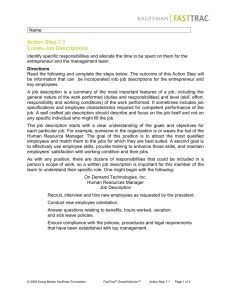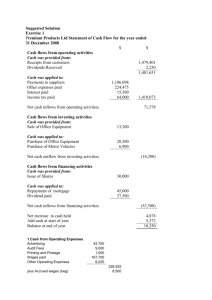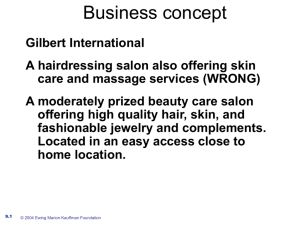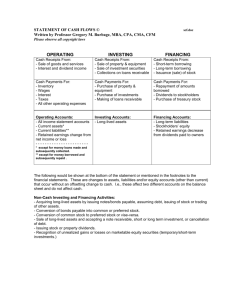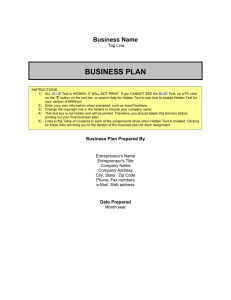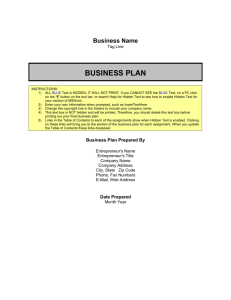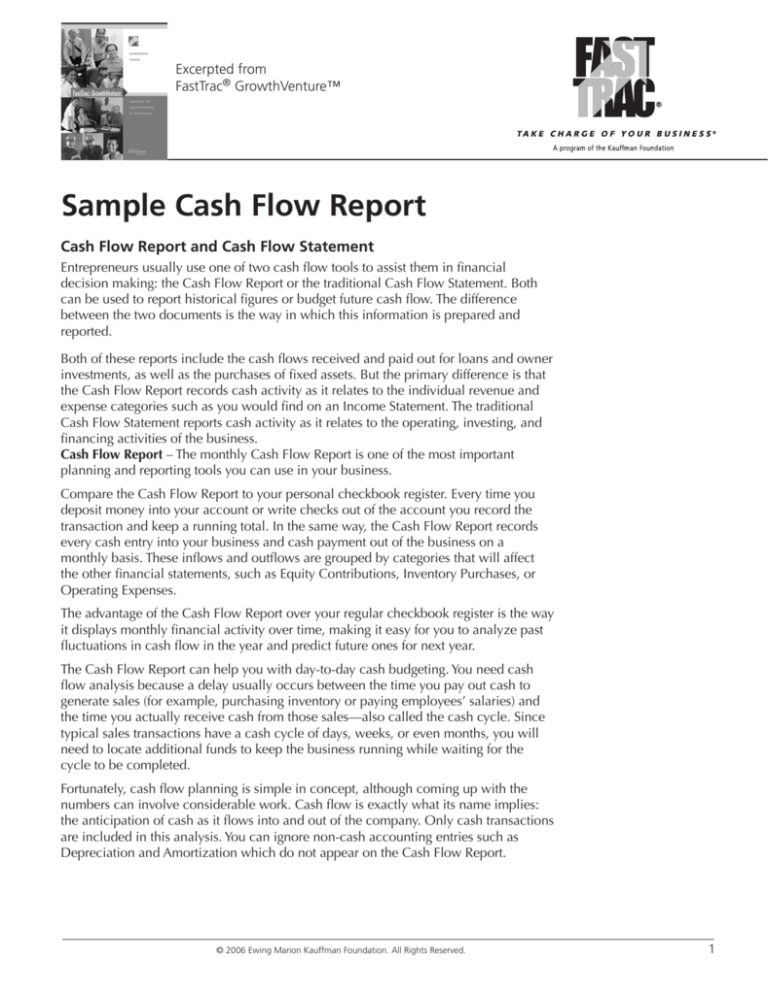
Excerpted from
FastTrac® GrowthVenture™
Sample Cash Flow Report
Cash Flow Report and Cash Flow Statement
Entrepreneurs usually use one of two cash flow tools to assist them in financial
decision making: the Cash Flow Report or the traditional Cash Flow Statement. Both
can be used to report historical figures or budget future cash flow. The difference
between the two documents is the way in which this information is prepared and
reported.
Both of these reports include the cash flows received and paid out for loans and owner
investments, as well as the purchases of fixed assets. But the primary difference is that
the Cash Flow Report records cash activity as it relates to the individual revenue and
expense categories such as you would find on an Income Statement. The traditional
Cash Flow Statement reports cash activity as it relates to the operating, investing, and
financing activities of the business.
Cash Flow Report – The monthly Cash Flow Report is one of the most important
planning and reporting tools you can use in your business.
Compare the Cash Flow Report to your personal checkbook register. Every time you
deposit money into your account or write checks out of the account you record the
transaction and keep a running total. In the same way, the Cash Flow Report records
every cash entry into your business and cash payment out of the business on a
monthly basis. These inflows and outflows are grouped by categories that will affect
the other financial statements, such as Equity Contributions, Inventory Purchases, or
Operating Expenses.
The advantage of the Cash Flow Report over your regular checkbook register is the way
it displays monthly financial activity over time, making it easy for you to analyze past
fluctuations in cash flow in the year and predict future ones for next year.
The Cash Flow Report can help you with day-to-day cash budgeting. You need cash
flow analysis because a delay usually occurs between the time you pay out cash to
generate sales (for example, purchasing inventory or paying employees’ salaries) and
the time you actually receive cash from those sales—also called the cash cycle. Since
typical sales transactions have a cash cycle of days, weeks, or even months, you will
need to locate additional funds to keep the business running while waiting for the
cycle to be completed.
Fortunately, cash flow planning is simple in concept, although coming up with the
numbers can involve considerable work. Cash flow is exactly what its name implies:
the anticipation of cash as it flows into and out of the company. Only cash transactions
are included in this analysis. You can ignore non-cash accounting entries such as
Depreciation and Amortization which do not appear on the Cash Flow Report.
© 2006 Ewing Marion Kauffman Foundation. All Rights Reserved.
Sample Cash Flow Report
Taking Action
The Cash Flow Report lists the sources of cash
expected to be received into the business on
a monthly basis. This list includes cash sales,
collections from accounts receivables, equity
contributions from owners, and loans from
either owners or outside sources. The cash
you expect to receive is added to the cash
balance remaining
from the prior month to total the cash
available for that month. You deduct all
items paid for with cash from the total cash
available to identify the cash balance at
the end of the month. This amount must
always be above zero. In fact, you should
try to maintain a healthy cushion to cover
unexpected differences between budgeted
cash flow and actual cash transactions.
Backyard Solutions
Cash Flow Report (Projected)
2005
JAN
Cash In
Cash Sales
$ -
Collections from Accounts Receivables
15,504 Equity Received
-
Loans Received
20,000 Other Cash In (receipts from other assets)
-
Other Cash In (interest, royalties)
-
Total Cash In
35,504 Total Cash Available
45,504 Cash Out
Inventory Expenditures
Inventory/Raw Material (cash)
8,363 Inventory/Raw Material (paid on account)
-
Production Expenses
2,256 Operating Expenses
Advertising
- Bank Charges
- Dues & Subscriptions
- Insurance
225 Licenses & Fees
215 Marketing & Promotion
3,500 Meals & Entertainment
1,000 Miscellaneous
100 Office Expense 150 Office Supplies
- Outside Services
70 Payroll Expenses
Salaries & Wages
2,000 Payroll Taxes
300 Benefits
1,000 Professional Fees
1,200 Property Taxes
- Rent
4,200 Repairs & Maintenance
- Shipping & Delivery
- Telephone
300 Training & Development
- Travel
5,000 Utilities
500 Vehicle
120 Leased Equipment
400 Other -
Other
- Paid on Account
-
Non-Operating Costs
Capital Purchases
- Estimated Income Tax Payments
- Interest Payments
309 Loan Principal Payments
594 Owner’s Draw
500 Other Cash Out - Total Cash Out
32,302 Monthly Cash Flow (Cash In – Cash Out)
3,202 Beginning Cash Balance
10,000 Ending Cash Balance
$13,202
© 2006 Ewing Marion Kauffman Foundation. All Rights Reserved.
FEB
$ 13,798
13,798
27,000
8,363
2,256
225
200
100
150
70
2,000
300
1,000
200
4,200
350
500
120
400
306
598
500
21,838
(8,040)
13,202
$ 5,162
Sample Cash Flow Report
Taking Action
Cash Flow Statement – The traditional Cash
Flow Statement prepared by accountants
reconciles the changes that occur within the
Balance Sheet accounts with the cash provided
from the operations of the business. The cash
flows from investing and financing activities are
also reported. Although these statements can be
used to budget future cash flows, they are more
effective at reporting actual cash activity than at
budgeting predicted activity.
Backyard Solutions
Statement of Cash Flows for the Year Ending 2005
(Projected)
Cash Flows from Operating Activities
Net Income
$ 57,705
A
djustments to reconcile Net Income to Net Cash provided by operating activities:
Depreciation & Amortization Expense
14,095
Decrease in Accounts Receivable
2,650
Decrease in Inventories
5,730
Decrease in Accounts Payable
(6,834)
Net Cash Provided by Operating Activities 73,346
Cash Flows from Investing Activities
Purchase of Property, Plant, & Equipment
(25,000)
Net Cash Used by Investing Activities
Cash Flows from Financing Activities
(25,000)
40,000
(7,026)
(6,000)
25,000
Proceeds from Loans
Principal Payment on Loans
Payment of Owner’s Draws
Proceeds from Issuance of Stock
Net Cash Provided by Financing Activities
51,974
Net Increase in Cash
100,320
Cash at Beginning of Year
Cash at End of Year
© 2006 Ewing Marion Kauffman Foundation. All Rights Reserved.
10,000
$110,320


